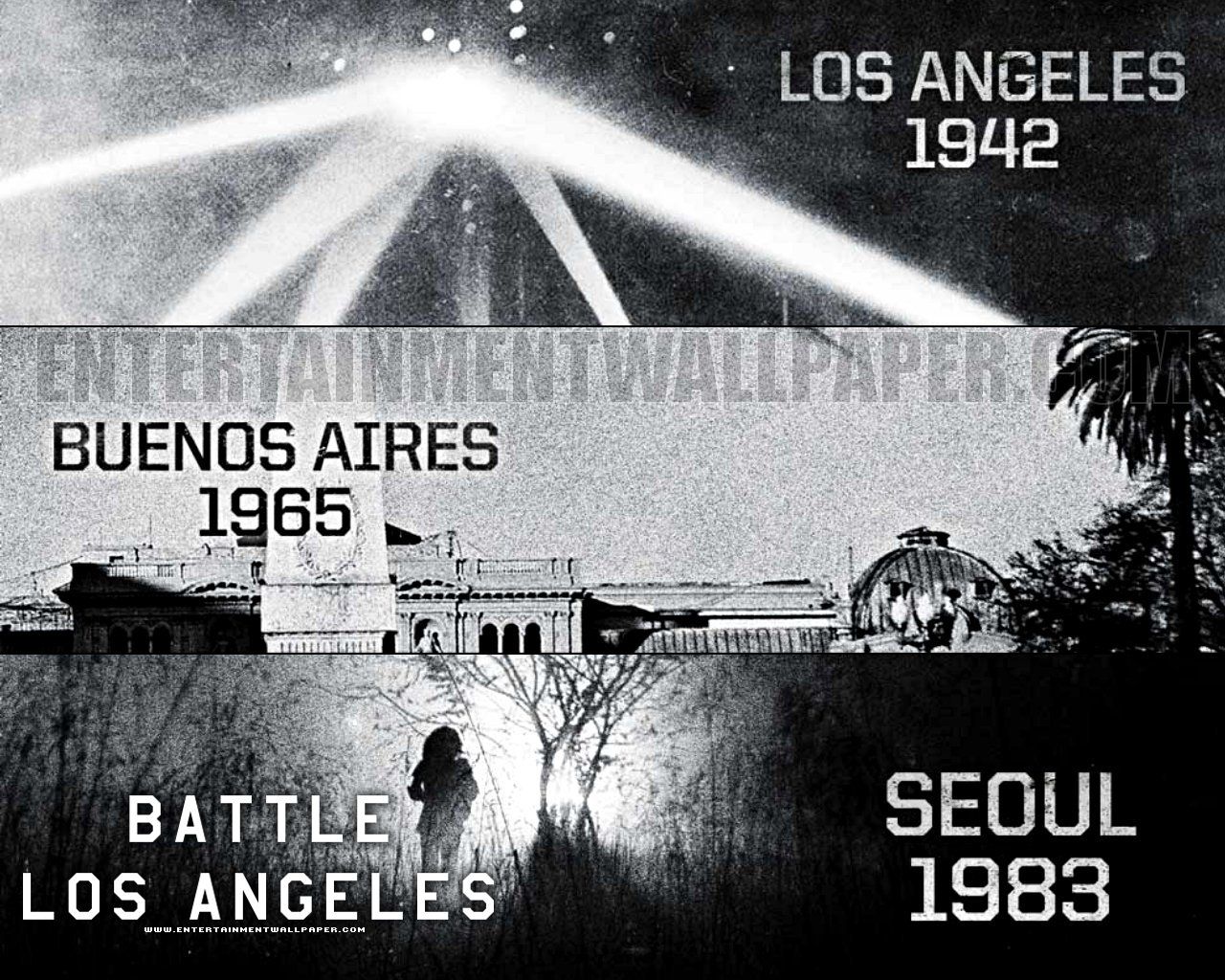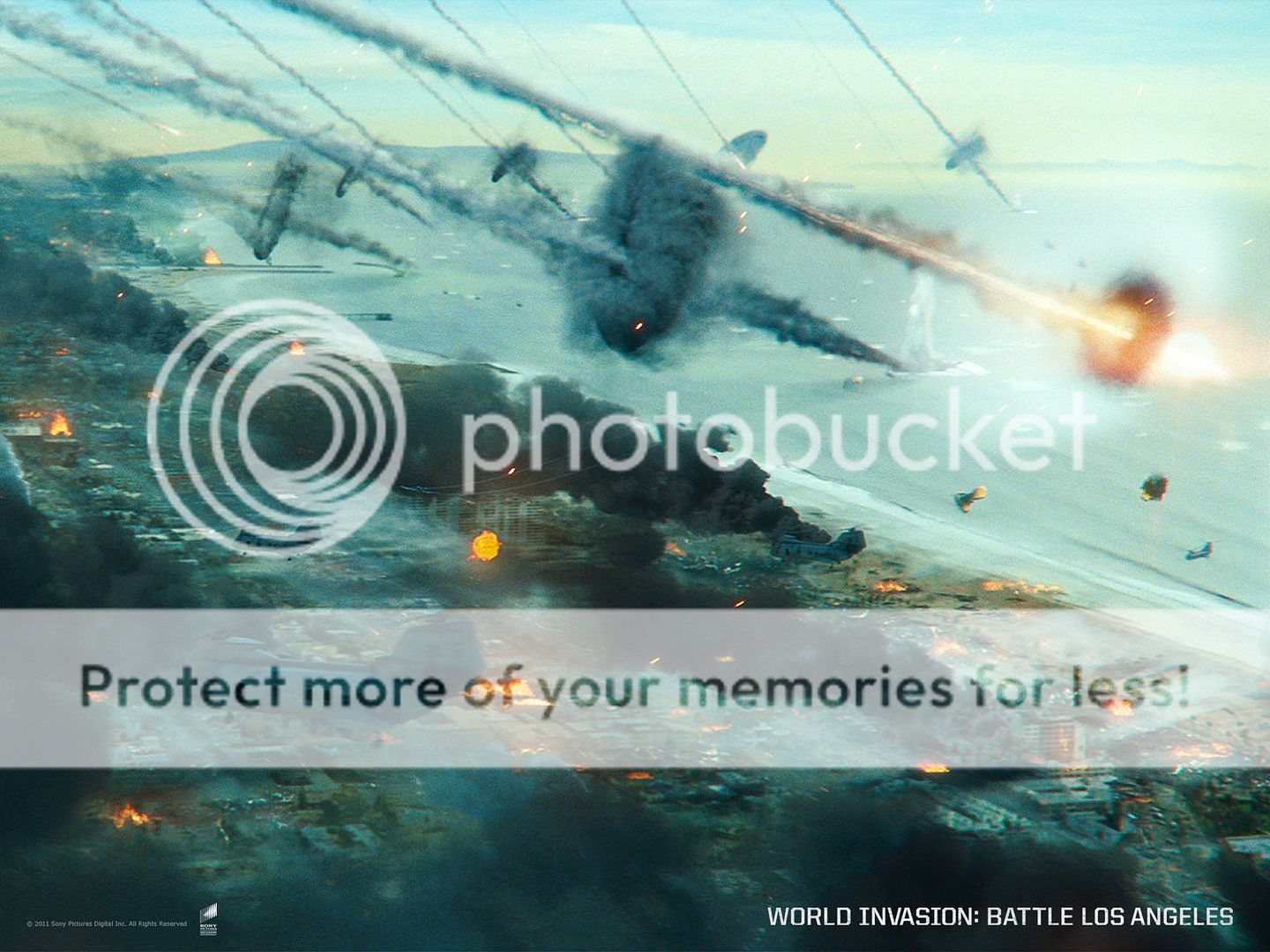
©2011 Sony Pictures Entertainment, all rights reserved.
Imagine the end-of-the-world, fiery destruction of Armageddon and Deep Impact. Now ratchet up the action with the artillery of Saving Private Ryan and the greatest war movies you’ve ever seen. Add in a dash of sci-fi with highly evolved aliens—a hybrid of the metalloid Cylons of Battlestar Galactica and a gooier version of the extra-terrestrial from Alien. Top it off with some of the best computer generated imagery (CGI) of any recent film, and you have Battle: Los Angeles, Sony’s much-anticipated spring blockbuster that first caught our attention this summer at San Diego Comic-Con. ScriptPhD.com was fortunate to get a sneak peek this week in Los Angeles. Click “continue reading” for our complete review of Battle: Los Angeles.
REVIEW: Battle: Los Angeles
ScriptPhD.com Grade: B+
Surfers soaking up sunshine. Marines running on the sand of San Diego’s beaches. An idyllic scene of Southern California that is the envy of the world. Little do they know that in 24 hours, the world would be pulverized by a coordinated terrorist attack from outer space. The nonchalant events leading up to the final battle include the retirement of burnt out career Marine Staff Sergeant Michael Nantz (Aaron Eckhart), who no longer wants the military life. His last mission involves a routine training session under the command of booksmart but green rising star William Martinez (Ramon Rodriguez). Their platoon is rounded out by a group of rookies, an alcoholic, an African doctor serving to get his US citizenship, and the brother of the man Nantz supposedly let die in Iraq—you know, the usual group you’d tag to save the world from mass extinction. A casual story floats on the news about a group of pending asteroids headed for Earth (no one seems all that concerned about the fact that eight of them are going to hit the coasts of major global cities), and the movement of civilians away from coastal danger zones. It isn’t until a chilling impact sequence (one of the film’s finest) that scientists deduce that the asteroids are in fact highly clustered attack machines and that the Earth is at war. The Second Battalion’s central mission is now to rescue five civilians trapped in a police station and get out of the blast zone before a bomb is dropped on the aliens in Santa Monica. Unfortunately, on the way over, all the military units are wiped out, as is the majority of global infrastructure, communication, and life (save for the apparently indestructible CNN, which miraculously keeps airing coverage long after the aliens should have shot its towers and reporters down).

United with the group of civilians and children, the Second Batallion realizes it’s them vs. the aliens to save the city, and possibly, the world. So our band of intrepid geniuses deduces that their best route out of the nuclear zone is—wait for it—the freeway! In Los Angeles? Really?! As predictably as a 405 traffic jam, they are cornered by the terrorists, who are adept at using our signals to track us. The group is, however, able to ensnare a wounded alien and figure out its physiology, vulnerabilities and the fact that they are after our water supply as a source of power. At this point, Battle: Los Angeles descends into a survivalist war drama, and a very compelling one at that, in which an emotionally devastated, abandoned group of damaged soldiers must rely on one another to creep undetected—fighting aliens every step of the way—toward the epicenter of the entire operation for their one chance to destroy the enemy and save our planet as we know it.
No pressure or anything.
Near-Earth objects (NEOs), which encompass asteroids, meteorites, and comets, among other objects floating about in space, have been responsible for three major extinctions on Earth, the most famous being the Chicxulub asteroid impact responsible for the mass extinction of the dinosaurs. NASA technology for monitoring NEOs exists, but a mere 0.03% of their budget, $5.8 million, is allocated for “planetary defense.” “Defending Planet Earth”, a 2010 National Research Council study advocates increasing this funding and development of strategies to
mitigate any potential deadly impact. In addition to several recent asteroid impacts and meteor showers,
there exists a vast list of far more nebulous list of documented UFO sightings (see complete list here). “I love how the real-life event just grounds the movie,” says Battle: Los Angeles producer Ori Marmur. “For the film, we decided that all previous UFO sightings were scouting missions… gearing up for the coming invasion by unknown forces.” An invasion that was so well-coordinated, that clusters of weapons posing as meteorites that would normally be detected months ahead of time surfaced in less than four hours. All things taken into consideration, how could this possibly happen? We spoke with Kevin Grazier, science advisor to Battlestar Galactica and a principal scientist on the Saturn Mission at the Jet Propulsion Laboratory in Pasadena, CA. “It’s not about NASA technology,” Grazier said. “The objects [alien warships in this case] would have to be cloaked to resist detection in the visible portion of the electromagnetic spectrum simply because there are so many amateur astronomers and telescopes turned to the heavens, searching for comets and/or near-Earth objects.” Put simply, the technology that invades Earth simply falls outside of our radar detection. And, because the filmmakers base their premise on previously-detected UFO visits (something that is not made clear in the film outside of press notes), it is entirely plausible that the visitors would adapt their warfare for the ultimate invasion.

In the end, Battle: Los Angeles, while far from a perfect film, offers enough entertaining components to satisfy the diverse audience it is surely being marketed to. There is a passably interesting, if somewhat rote, script with the requisite hint of romance and adorable kids that every disaster movie necessitates. The CGI renderings of alien warfare and a decimated, burning Los Angeles are so impressive that, driving near downtown today, I did a double take at the perfect vista that had been an irrecognizable inferno on the big screen the night before. Indeed, star Aaron Eckhart confirmed that the movie was shot primarily on green screen, making the digital renderings of the devastation frame by frame all that more impressive of a technical achievement. And the personalities of the Second Batallion, as well as the demonds they must collectively overcome, provide the film with enough of a human angle to supplement the non-stop shellfire that is the film’s primary soundtrack. It is, however, the last hour of the film, a sustained artillery salvo that took the audience’s breath away, that is worth the price of admission. Just when you think the humans have defeated the largest, most powerful piece of alien technology, it gets bigger and badder, all the way to the stunning conclusion.
And for all you worryworts out there—relax! Not only are NASA scientists continually adapting and developing NEO detection technology, your chances of actually dying from a meteorite, as calculated by astronomer Alan Harris, are 1 in 700,000, ranking right up there with dying at an amusement park ride. And as for highly-evolved alien life, even last weekend’s hype over the potential discovery of cyanobacteria in a meteorite rock by a NASA appears to be… lines and squiggles on a rock. So, in the spirit of great sci-fi, grab a seat, a buttery bag of popcorn, and get ready for a good old-fashioned human versus alien shoot ‘em up action adventure.
Official Trailer:
Battle: Los Angeles goes into wide theatrical release on Friday, March 11, 2011.
~*ScriptPhD*~
*****************
ScriptPhD.com covers science and technology in entertainment, media and advertising. Hire our consulting company for creative content development.
Subscribe to free email notifications of new posts on our home page.

